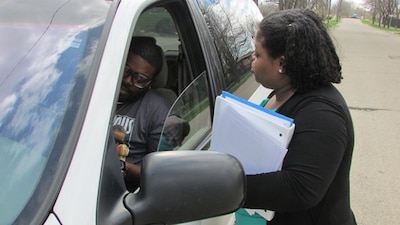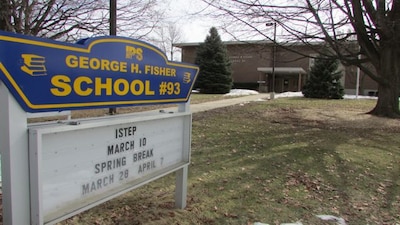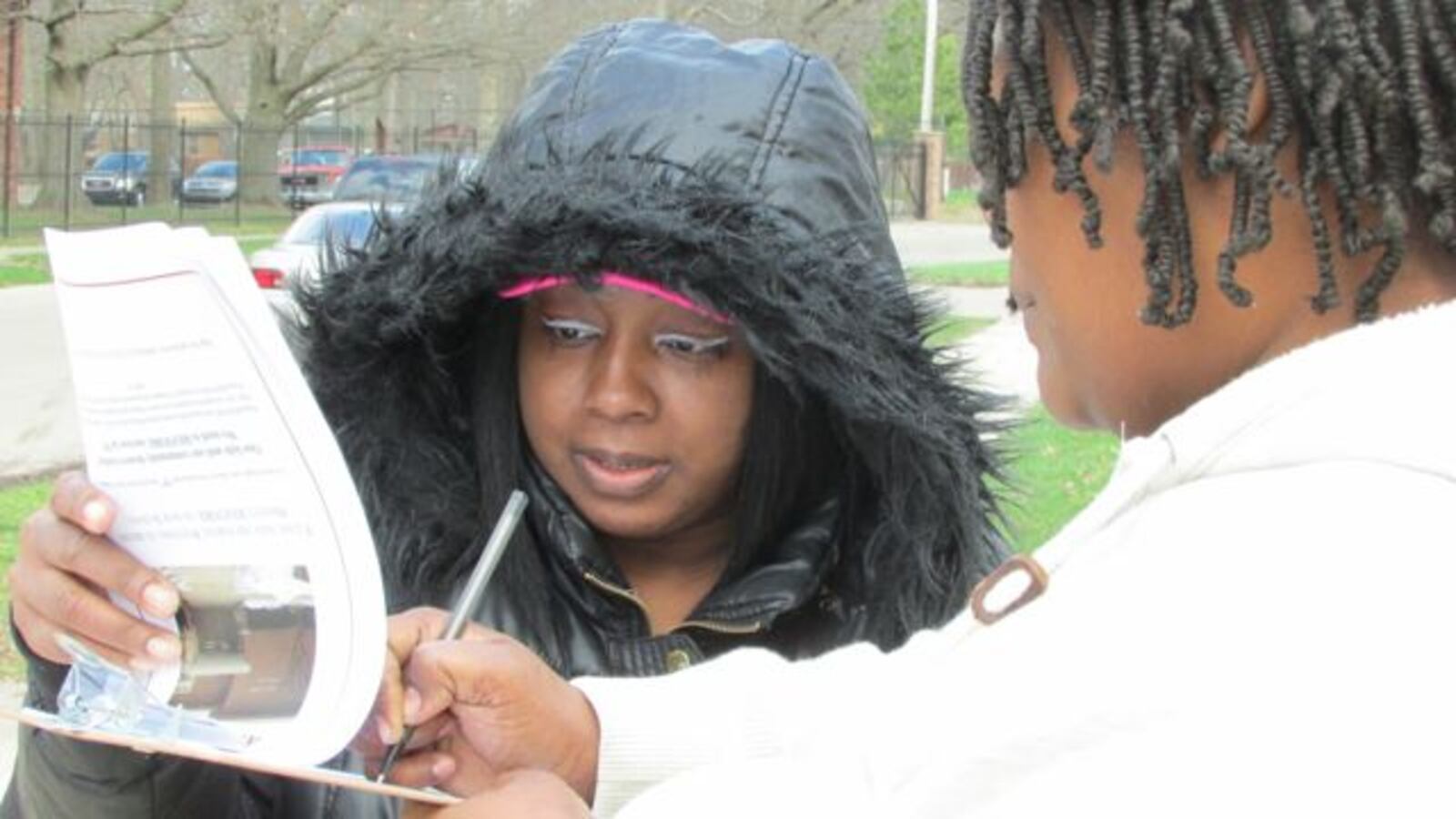While other School 93 parents pulled up to the building wearing knit hats and heavy jackets against Tuesday’s unusually bitter cold at the school day’s end, a coatless Kesha Harris chased along behind them, clipboard and pen in hand.
“Have you signed our petition yet?” she asked, staying warm apparently only from her frenetic movements.
Harris was in a group of parents working the sidewalk, aiming to collect just 11 more signatures so they could present to the Indianapolis Public School Board with 100 names in support of their mission: to bring the district’s Project Restore program to their school.
“We’re at the F level,” Harris said. “If that isn’t a reason to bring them here, what is?”
The effort to overhaul School 93, also called George H. Fisher Elementary School, has several elements that are potentially groundbreaking for IPS.
In this case, the impetus for change is coming not from the central office, but is driven by parents and teachers. They’ve been aided by a new initiative of an outside group, Stand For Children. And the reform they are aimed squarely at adopting is not a national model or magnet theme. It’s a homegrown, IPS-invented program with a track record of success at the kinds of low performing neighborhood schools that plague the district.
Facing tough challenges
School 93 is deeply troubled, ranked in the bottom 15 percent of schools in one of the poorest performing school districts in the state. Only six of 56 IPS schools that took ISTEP had a lower passing rate than School 93’s 30 percent in 2013.
The school’s trend line is even more concerning. Between 2005 and 2009, School 93 actually earned two A’s and a B. But since then it has been rated an F three consecutive years and this year landed on Superintendent Lewis Ferebee’s list of 11 high priority schools targeted for extra attention because of low and declining test scores. School 93’s passing rate has fallen by an alarming 23 percentage points since 2008.

Why?
Special education teacher Kevin Ludwig has some theories. The school’s population has changed over his three years there, he said. Ludwig remembered an unusual influx of more than 100 new students from other schools in a single year, possibly driven by redistricting or another school being closed. That’s a lot of new students for a school of just 349 kids.
The school’s students face significant challenges and troubled home lives. This year alone, Ludwig said, two students at the school have been shot in incidents in their homes. Another significant subset of its students are homeless or in foster care.
“Every teacher up here can tell you of situations where they are simply at a loss as to how to reach and inspire our children to learn,”Ludwig told the school board Tuesday night. “To be clear, it is not the fault of our young people. Our students walk into school every day with terrible, tragic and overwhelming challenges.”
Some of School 93’s other numbers: 89 percent of its children are poor enough to qualify for free or reduced-price lunch, 90 percent are minorities and 20 percent are in special education.
Similar schools see more success
Even so, another East side school with similar challenges just a couple miles away is on an opposite trajectory — getting the better results School 93 teachers and parents covet.
School 99, also known as Arlington Wood Elementary School, was an F school in 2009 when two of its teachers, Tammy Laughner and Dan Kriech, created what became Project Restore and ultimately persuaded the rest of the school to try it. Project Restore is a schoolwide reform model aimed at improving discipline through consistent rule enforcement and promoting better student learning through frequent testing and review of what’s been taught.
School 99, where it all began, has a profile that is much the same as School 93: 88 percent of School 99’s kids are poor, 93 percent minority and 16 percent in special education. Like School 93, its students had trouble with low test scores and disruptive behavior.
Laughner and Kriech’s approach had several distinctive features. For discipline, they outlined 20 common, serious offenses — 10 that result in suspension and 10 that earn students a trip to the discipline office. Discipline deans handle it all, including calling parents.
“Teachers just keep on teaching,” Laughner said. “Teachers like that.”
There is also a system of rewards when students do well and competitions to earn prizes for good academic work. Every class routinely posts its test scores, for example, identifying the top scoring classrooms.
Instruction in math is an example of how Project Restore works. Cumulative tests Laughner and Kriech created add new concepts as students learn them and the tests get longer each time. But students are always tested on what they had previously learned, building in review.
“They are constantly reinforcing the curriculum,” said Ludwig, who previously taught at School 99. “Kids prepared for ISTEP this way. They walked in to ISTEP with heads high and were like, ‘I got this.’ And they did.”
In five years, School 99 went from 31 percent passing to 60 percent passing before a slight dip to 58 percent last year. Still, the school remains in the top quarter of IPS schools when it comes to passing ISTEP. It reached an A in 2012 before sliding to a C last year after the test score drop.
Just a few miles down the road, however, Project Restore’s second turnaround story did the flagship school one better.
School 88, named the first Project Restore expansion site in the fall of 2012, jumped from an F to an A in one year on the strength of a 19-point jump on ISTEP to 56 percent passing. Its profile compares strongly with Schools 99 and 93: School 88’s students are 90 percent poor, 78 percent minority and 18 percent in special education.
Ferebee said he’s been impressed with Project Restore’s track record.
“We do choice really well between charters and magnet schools in Indianapolis,” he said. “But this is a promising model for neighborhood schools that we should explore.”
Getting outside help
Lechess Taylor had never heard of Project Restore before she started attending Stand Up classes. But she liked what she heard. Her son, Anthony, is in first grade and has a long way to go before he’s done at School 93.
“I want my son to learn more and to get him ready for college,” she said.

Stand Up is an initiative of Stand for Children, a group that advocates for educational change in IPS. Parents at three IPS schools signed up for its 10-week course, in which they learn how to be better informed advocates for their children.
In the class, parents learn about how to analyze school test data, how to assess whether their kids are on a track to be ready for college and other skills. One presentation was on Project Restore.
“We found if you provide parents with information on how their school is doing and how it relates to their child’s future they want to take action,” said Stand’s executive director, Justin Ohlemiller. “We saw the lightbulb go off that their kids’ lives are at stake.”
Harris was among the parents who quickly saw value in Stand Up for herself and her children.
“I joined immediately,” she said. “My question was, what a I supposed to do as a mom?”
School 93’s poor performance was quickly identified by parents in the group as a concern to be addressed. They didn’t like their school being rated an F.
“You can’t go any further down,” said Eugenia Murray, mother of three students at the school. “My children do well here but it’s not just about my children.”
With 100 parent signatures gathered and near unanimous teacher support, the group came to Tuesday night’s school board and asked for an endorsement their plan. Ludwig spoke for a group of six teachers who made the plea.
“We believe Project Restore is exactly what we need to change the trajectory of our school and to provide our students with the confidence and structure necessary for them to succeed in the classroom,” he said. “We’ve put in countless extra hours trying to turn our school around. But we’re not getting the results we want or our young people deserve. So we respectfully request your help.”
Ferebee was pleased by the strong support of teachers and parents.
“When you have community support, and the number of signatures they had, we should give an opportunity to hear more,” he said. “I’m inclined to be very supportive of it.”
The biggest questions in Ferebee’s mind are logistical. The district has already announced plans to seek a new principal for the school. Among his questions: Is there a potential candidate to lead the school with Project Restore experience who would be a good fit? Should the school be part of IPS’s “innovation school” network that is trying out new ideas? Or should it operate independently under a new law just passed by the Indiana Legislature?
Whatever the set up, Murray said parents are ready to support the turnaround push.
“Hopefully we can get it turned around from an F school to an A school,” she said. “It’s going to be a collaborative effort.”


